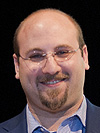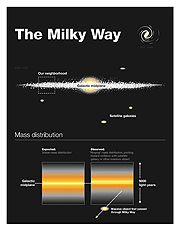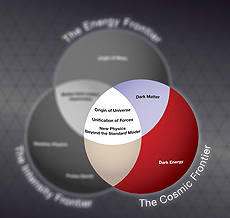|
Have a safe day!
Friday, June 29
2 p.m.
Accelerator Controls Seminar - One West
Speaker: Jim Patrick, Fermilab
Title: Control System Application Development in Java
3:30 p.m.
DIRECTOR'S COFFEE BREAK - 2nd Flr X-Over
THERE WILL BE NO JOINT EXPERIMENTAL-THEORETICAL PHYSICS SEMINAR THIS WEEK
Monday, July 2
9 a.m.
Special Joint Experimental-Theoretical Physics Seminar - Ramsey Auditorium
Speakers: Wade Fisher, Michigan State University and Eric James, Fermilab
Title: CDF and DZero Higgs Results with the Full Tevatron Data Set
3:30 p.m.
DIRECTOR'S COFFEE BREAK - 2nd Flr X-Over
4 p.m.
All Experimenters' Meeting - Curia II
Special topics: Shutdown Work Status and Plans; Proton Improvement Plan (PIP)
Click here for NALCAL,
a weekly calendar with links to additional information.
Upcoming conferences |
Friday, June 29
- Breakfast: Chorizo burrito
- Smart cuisine: Italian vegetable soup
- Chicken fajita sandwich
- Southern fried chicken
- Smart cuisine: Mediterranean baked tilapia
- Eggplant parmesan panini
- Assorted sliced pizza
- Assorted sub sandwiches
Wilson Hall Cafe Menu
|
|
Friday, June 29
Dinner
- Warm fennel salad
- Lobster tail w/ lemon butter sauce
- Spaghetti squash w/ scallions
- Grilled asparagus
- Blueberry tartlets w/ lime curd
Wednesday, July 4
Lunch
Closed
Chez Leon Menu
Call x3524 to make your reservation.
|
|
Alex Himmel wins 2012 URA Thesis Award
 |
Alex Himmel
Photo: Reidar Hahn |
When he was 16, Alex Himmel had his first job at Fermilab as a summer student. He’s been investigating particle physics ever since, and this year he received the Universities Research Association Thesis Award for his research on muon antineutrino oscillations at Fermilab’s MINOS experiment.
As a doctoral student at Caltech, Himmel researched muon neutrinos at MINOS. In his data, he found measurements suggesting that muon antineutrinos in the MINOS beam behaved differently than muon neutrinos.
“Originally, nobody cared about antineutrinos,” said Himmel, now a postdoctoral fellow at Duke University. “We started looking at the antineutrinos that were just there in the beam, and after seeing something a little strange, we decided to dedicate ourselves to the antineutrino signal.”
Himmel and his collaborators used a beam made only of antineutrinos to study their behavior. Other scientists initially pushed back, he said, since they had assumed muon antineutrinos would follow charge-parity symmetry and behave exactly like muon neutrinos. They believed that, for advancing particle physics, other measurements were more pressing.
But what Himmel found was evidence that muon antineutrinos did not oscillate as frequently as muon neutrinos – a possible break from the CP symmetry predicted by the Standard Model.
“The award is a nice validation that the physics was ultimately interesting to the community,” Himmel said.
Bob Zwaska, who chairs the URA Thesis Award committee, said Himmel’s research was a significant part of the MINOS program. The award committee selected Himmel’s thesis from 19 nominations across Fermilab from all fields.
"You would think that neutrinos and antineutrinos behave similarly in this search," Zwaska said, "but he studied the differences and found hints that took quite a bit of effort to tease out."
Those hints linger on, and while Himmel said further research at MINOS has suggested that muon neutrinos and muon antineutrinos are more similar than not, he added that the NOvA experiment has the potential to better define their individual characteristics.
“Alex is certainly worthy of this award,” said Marta Cehelsky, executive director of URA. “He was a terrific candidate, and this is an impressive piece of work.”
—Joseph Piergrossi
|
Scientists discover that Milky Way was struck some 100 million years ago, still rings like a bell
 |
Scientists have found evidence that the Milky Way had an encounter with a small galaxy or massive dark matter structure roughly 100 million years ago. Image: Fermilab
|
Our galaxy, the Milky Way, is a large spiral galaxy surrounded by dozens of smaller satellite galaxies. Scientists have long theorized that occasionally these satellites will pass through the disk of the Milky Way, perturbing both the satellite and the disk. A team of astronomers from Canada and the United States have discovered what may well be the smoking gun of such an encounter, one that occurred close to our position in the galaxy and relatively recently, at least in the cosmological sense.
"We have found evidence that our Milky Way had an encounter with a small galaxy or massive dark matter structure perhaps as recently as 100 million years ago," said Larry Widrow, professor at Queen's University in Canada. "We clearly observe unexpected differences in the Milky Way's stellar distribution above and below the Galaxy's midplane that have the appearance of a vertical wave -- something that nobody has seen before."
The discovery is based on observations of some 300,000 nearby Milky Way stars by the Sloan Digital Sky Survey. Stars in the disk of the Milky Way move up and down at a speed of about 20-30 kilometers per second while orbiting the center of the galaxy at a brisk 220 kilometers per second. Widrow and his four collaborators from the University of Kentucky, the University of Chicago and Fermi National Accelerator Laboratory have found that the positions and motions of these nearby stars weren't quite as regular as previously thought.
"Our part of the Milky Way is ringing like a bell," said Brian Yanny, of the Department of Energy's Fermilab. "But we have not been able to identify the celestial object that passed through the Milky Way. It could have been one of the small satellite galaxies that move around the center of our galaxy, or an invisible structure such as a dark matter halo."
Adds Susan Gardner, professor of physics at the University of Kentucky: "The perturbation need not have been a single isolated event in the past, and it may even be ongoing. Additional observations may well clarify its origin."
Read more
|
Peter Higgs in the spotlight
From Physics World, June 28, 2012
Peter Higgs is not someone who craves the limelight. He lives a quiet life in a flat in Edinburgh, the city where he spent the bulk of his academic career as a particle theorist, and rarely ventures into TV or radio studios to pontificate on the frantic hunt at CERN and Fermilab for the boson that bears his name. If anything, the 83-year-olds Higgs is acutely embarrassed by the term "the Higgs boson", which – he feels – singles him out at the expense of other theorists who were also involved in conceiving the core ideas that led to its prediction.
But while Higgs does not like to crow too much about himself, he is by no means some sort of recluse. Indeed, Higgs was delighted to give this special audio interview to Physics World while visiting Bristol last month as part of a series of other speaking engagements in the city. In the interview, he emphasizes that at least five other theorists – Robert Brout, Francois Engelert, Gerald Guralnik, Carl Hagen and Tom Kibble – deserve credit for predicting the Higgs boson, adding that "the person who is still slightly aggrieved is Phil Anderson, the condensed-matter theorist, who said he knew it all already".
Read more
|
|
Why study the cosmos?
 |
While the laws of physics set limits on what is possible, our universe could have evolved in different ways. Or could it? Studying the Cosmic Frontier teaches us about the history of the cosmos. Combined with information gained at particle accelerators, we can try to find out if the basic structure of our universe was inevitable.
|
Perhaps that is one of those "duh!" questions. After all, humans have wondered about the cosmos for all of recorded history and no doubt long before writing was invented. But there is a modern component to this query. One of the longest-asked questions is "How did the universe come into existence?" In previous Nutshells, we discussed the Energy Frontier, in which we try to reproduce the conditions of the early universe, and the Intensity Frontier, in which we search for rare phenomena to better understand all of the physical phenomena that went into forming the cosmos in which we live.
However those studies tell us what is physically possible. Just because something can happen, doesn't mean that it did happen. You might have taken today off and gone to the beach, but you probably didn't. Similarly, the history of the universe unfolded in a particular way. It's only by studying our universe that we can combine the physics of the possible discovered in particle physics labs with the story we see recorded literally in the stars. And it's only by studying the cosmos that we can understand how our universe evolved from the high-temperature conditions created in our accelerators to the familiar conditions we see today.
In addition, much of the later history of the universe (meaning after a millionth of a second or so) is heavily affected by the force of gravity. Gravity can reach across the light-years and assemble huge galaxies, majestic pinwheels in the sky, but it played no role in the very early universe, as the force was and is too weak to compete with the other known subatomic forces. To understand how gravity shaped our later universe, we need to study the heavens.
Other mysteries that studies of the sky can illuminate are the questions of dark matter and dark energy. While it might be possible that we can create dark matter in our accelerators, there is no guarantee that what we create is the same thing as the dark matter that makes galaxies spin inexplicably fast. It's going to take cosmological searches to answer that important question.
To understand our universe requires that we employ every tool available to us. Studying the cosmic frontier is one such tool. Combined with input from the Energy and Intensity Frontiers, we may finally begin to understand the crucible of creation in which our universe was forged.
—Don Lincoln
Click here to read the expanded column on the Cosmic Frontier.
|
July wellness offerings, fitness classes, employee clubs and discounts
Pool membership and swim lessons
The Fermilab pool will be open until August 26. Pool memberships are sold in the Wellness Office on the 15th floor of Wilson Hall.
Pool hours are:
- Tuesday to Friday, noon to 7 p.m.
- Saturday and Sunday, 1 to 6 p.m.
- Monday - closed
Single memberships are $100 and family memberships (up to four members per family) are $230. Additional family members may join for $40 each. Memberships are free for children 2 and under.
The pool daily rate is $8; after 5 p.m., the rate is reduced to $5.
Swim lessons are available for preschool children and youth at $65 per session. For more information, click here.
Fitness class:
- Yoga class meets
Tuesdays, July 3 to Aug. 21, from noon to 1 p.m. in Ramsey Auditorium.
$85 per person.
Employee club:
- The Fermilab Singers are preparing for their end-of-summer concert. All are welcome to join. The Singers meet on Wednesdays from noon to 1 p.m. in Ramsey Auditorium. For more information, e-mail Anne Heavy at aheavey@fnal.gov.
Featured employee discounts:
- Raging Waves Waterpark
- Fermi Days at Six Flags Great America
- Any Day tickets at Six Flags Great America
- Journey Cycle and BMX
For more information, e-mail Jeanne Koester in the Wellness Office at jkoester@fnal.gov.
|
|